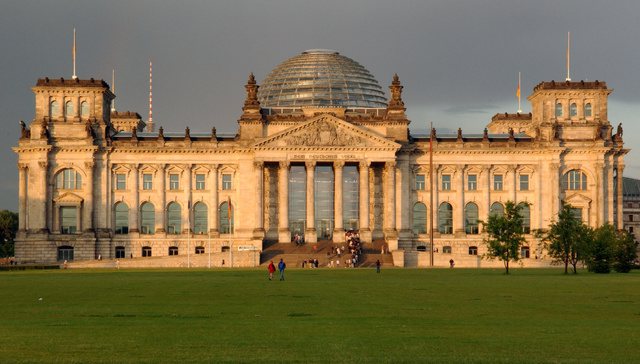I’m just back from Berlin where I was attending a conference run by the ECPRD – the association of European Parliamentary libraries. Usually I don’t go to these events as they’re not often about archival stuff; however, this year the theme was “Parliamentary history and its communication to the public” which was right up my street.
 Few Parliamentary buildings in the world can be more moving than the Reichstag in Berlin, which is where last week’s conference was based. The burning of the Reichstag in 1933 (staged as a “Communist” arson attack by the Nazis) ushered in Hitler’s rise to power. It was never used by Hitler or his regime, and lay derelict throughout the war. It was then further damaged in the Allied bombing of Berlin in the last days of the war, its dome reduced to a phantom skeleton and its walls scrawled with graffiti by the Red Army who had captured it.
Few Parliamentary buildings in the world can be more moving than the Reichstag in Berlin, which is where last week’s conference was based. The burning of the Reichstag in 1933 (staged as a “Communist” arson attack by the Nazis) ushered in Hitler’s rise to power. It was never used by Hitler or his regime, and lay derelict throughout the war. It was then further damaged in the Allied bombing of Berlin in the last days of the war, its dome reduced to a phantom skeleton and its walls scrawled with graffiti by the Red Army who had captured it. As if that wasn’t enough of a metaphor of the abandonment of democracy, after 1945 the building was situated only just inside the British zone of occupation. Subsequently, the Berlin Wall ran 7m from one of its flanks, placing it barely inside West Berlin. Close to a bend in the River Spree, the opposite bank of the river was in East Berlin, and a considerable number of people were killed by DDR border guards trying to swim towards the Reichstag building and – therefore – freedom. The West German government had decamped to Bonn but continued to use an undamaged part of the building for committee hearings (much to the annoyance of the DDR government).
As if that wasn’t enough of a metaphor of the abandonment of democracy, after 1945 the building was situated only just inside the British zone of occupation. Subsequently, the Berlin Wall ran 7m from one of its flanks, placing it barely inside West Berlin. Close to a bend in the River Spree, the opposite bank of the river was in East Berlin, and a considerable number of people were killed by DDR border guards trying to swim towards the Reichstag building and – therefore – freedom. The West German government had decamped to Bonn but continued to use an undamaged part of the building for committee hearings (much to the annoyance of the DDR government). On reunification, a massive project was launched to reinstate the Reichstag as the Parliament building of the Federal Republic of Germany. The Bundestag (MPs) would meet there, and the Bundesrat (ministers representing the German Laender) would have seats in the chamber, even though their building was on Leipziger Strasse (and had been unused during the DDR era). Just like the competition to rebuild the Houses of Parliament after 1834, entries from architects were anonymous. First prize was won by Sir Norman Foster, the British Architect (in fact, the top three winning plans, unknown to the judges at the time, were from non-Germans – the others being a Spaniard and a Dutchman). More symbolism: former enemies helping to rebuild its neighbour’s shattered Parliament building.
On reunification, a massive project was launched to reinstate the Reichstag as the Parliament building of the Federal Republic of Germany. The Bundestag (MPs) would meet there, and the Bundesrat (ministers representing the German Laender) would have seats in the chamber, even though their building was on Leipziger Strasse (and had been unused during the DDR era). Just like the competition to rebuild the Houses of Parliament after 1834, entries from architects were anonymous. First prize was won by Sir Norman Foster, the British Architect (in fact, the top three winning plans, unknown to the judges at the time, were from non-Germans – the others being a Spaniard and a Dutchman). More symbolism: former enemies helping to rebuild its neighbour’s shattered Parliament building.| Even the Soviet graffiti from 1945 on the interior walls has been uncovered and restored: looking as fresh as the day it was written. |
| Inside the Dome |